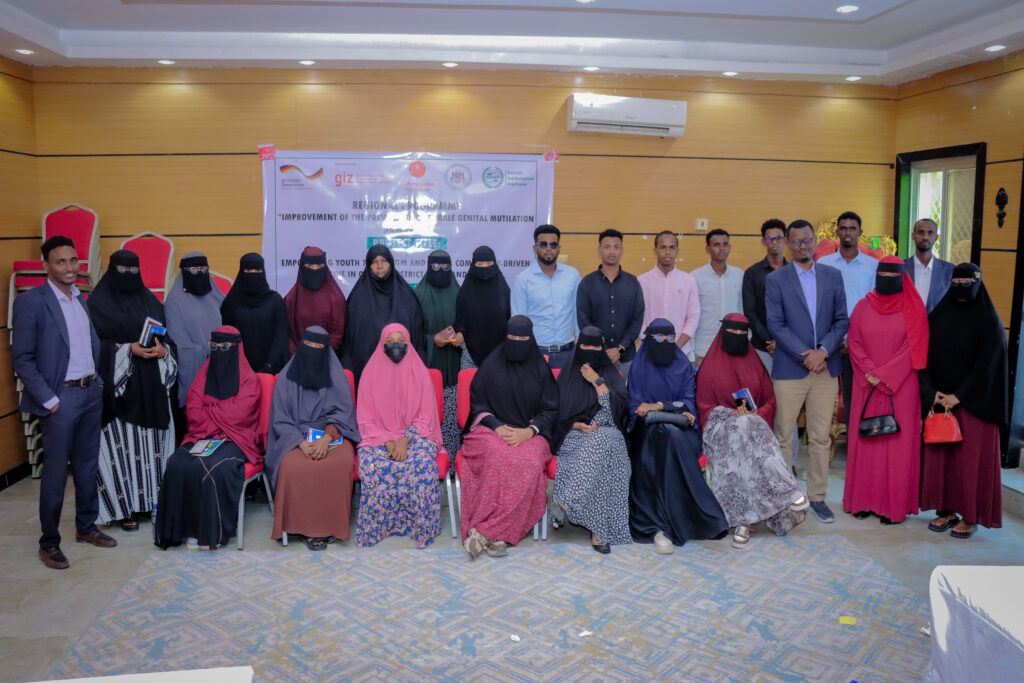

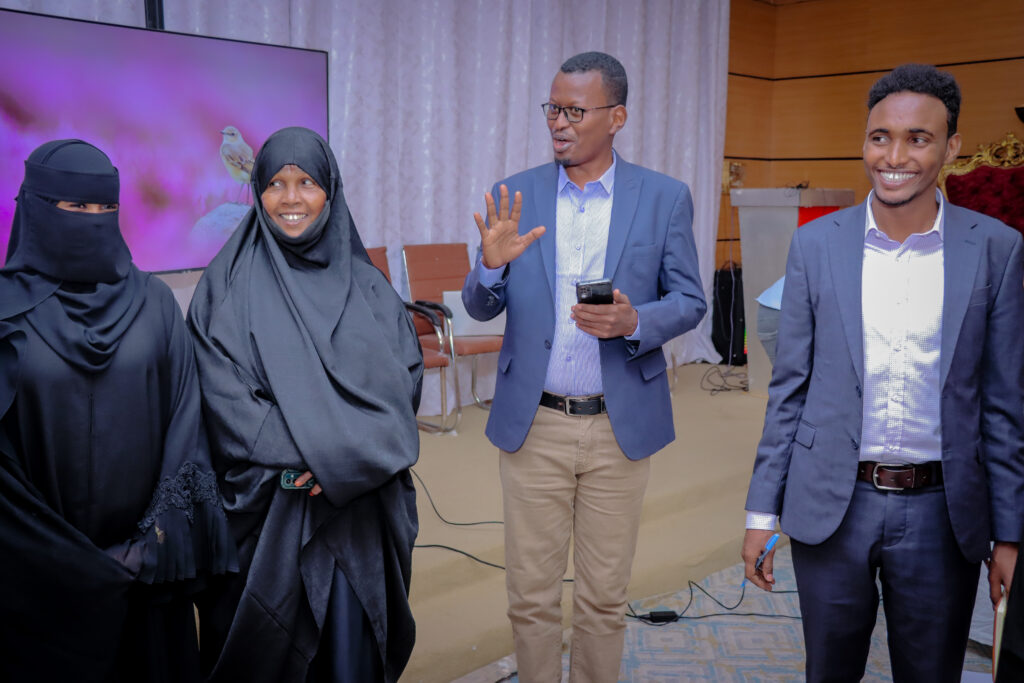

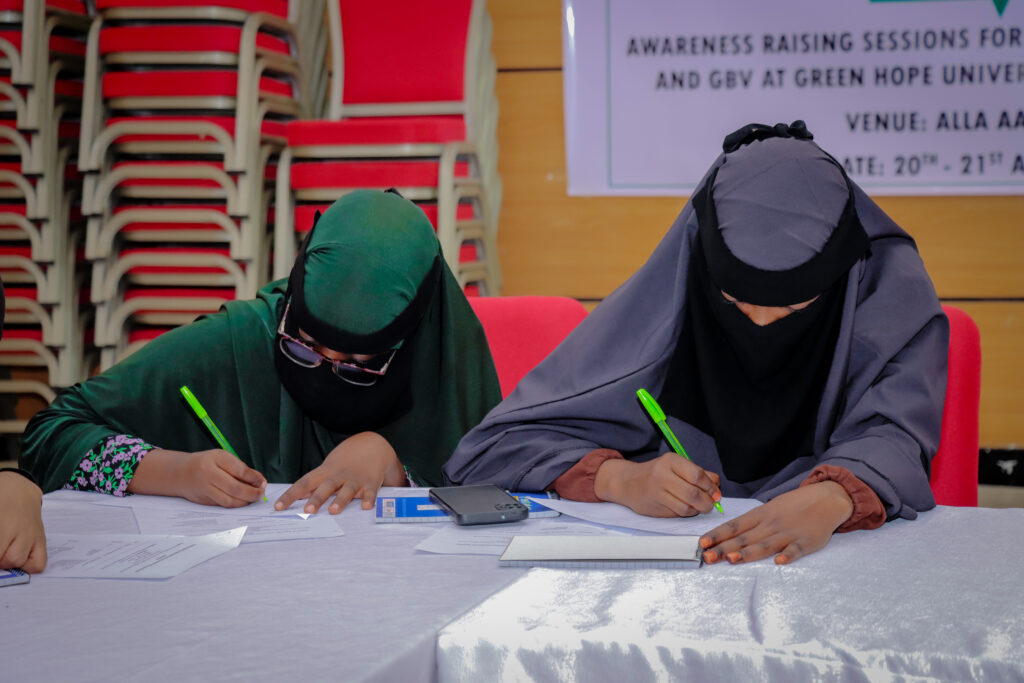
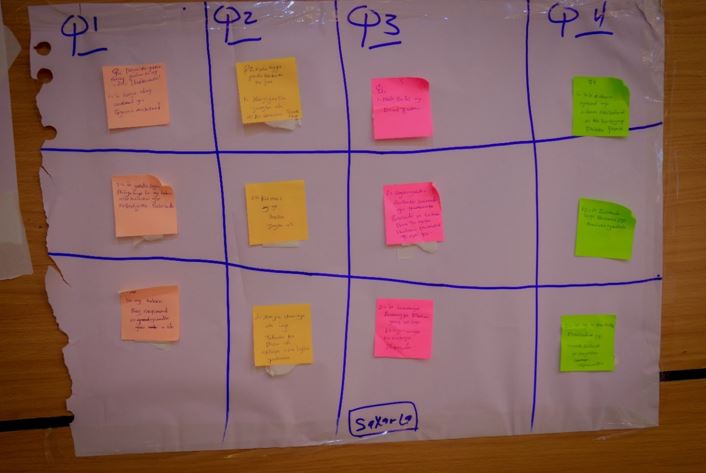

Building on the success of the initial awareness-raising sessions, SAAD Organization, in partnership with MOWDAFA and with support from GIZ, conducted an advanced, intensive training for ten (10) selected university student activists on October 2, 2025. FGM Prevention Training training marked a strategic shift from raising awareness to building actionable advocacy skills. Focusing on the precise deconstruction of religious misconceptions and medical myths surrounding FGM, the session equipped participants with the evidence and confidence to lead community dialogues. FGM prevention training outcome was the successful development of preliminary framework for Community Action Plans (CAPs), laying groundwork for community-owned roadmap leading by peer educators prepared to drive the movement against FGM in Qardho.
Following the baseline training of 54 students in September 2025, SAAD identified ten motivated university students for an advanced training programme on FGM prevention and other forms of GBV prevention with the potential to serve as activists within their peer groups and the broader community. This advanced training was designed to transform this potential into practical skill, moving beyond foundational knowledge, and empower activists to effectively counter the deepest-rooted justifications for FGM, particularly the conflation of the “Sunna” type with Islamic doctrine and the misconception of its medical acceptability.
The training FGM prevention was designed to achieve the following specific objectives. By the end of the session, participants were expected to be able to:
- Confidently articulate, using Islamic and medical evidence, that no form of FGM is medically benign, beneficial, or an Islamic requirement.
- Lead critical discussions using comparative case studies to reframe FGM as a harmful cultural practice.
- Crafting a framework for a Community Action Plan with specific steps for prevention, survivor support, and community empowerment that can reinforce each to end FGM.
- Comparative Case Study Analysis: In-depth group discussions on foot-binding in China and lip plates in Ethiopia were used to build a critical framework for analyzing harmful traditions.
- Deconstruction of Religious Myths Sessions: Facilitator-led presentations and group discussions provided a detailed analysis of the term “Sunnah,” the sources of Islamic law, and the weakness of hadiths used to justify FGM.
- Interactive Lectures: Sessions reinforced the universal health harms of all FGM types and introduced advocacy principles.
- Action-Oriented Group Work: Participants collaborated to brainstorm and structure their initial Community Action Plans.
4.1 Opening event
On 2nd October, 2025, Ms. Sahra Jaqanaf, Coordinator of the Ministry of Women Development and Family Affairs (MOWDAFA) for Karkar region opened the first of series of trainings designed to prepare University student activists that will educate their peers and broader Qardho community to end FGM. Ms. Sahra congratulated the selected students, and thanked them for the commitment and enthusiasm they shown in the previous training. She also extended her gratitude to SAAD Organization and GIZ for their efforts.
4.2 Session I: Reframing FGM through a Global Lens
This session built upon previous introductions to global harmful practices like foot-binding[1] and lip-plating[2] practiced in China and Ethiopia respectively. Participants unanimously condemned these practices as unnecessary and harmful in the previous training. That exercise was important, as it established an objective standard for evaluating harmful traditions.
In this training, participants were asked to compare the most common type of FGM in Somalia with those harmful traditions with the intention to draw some parallels among these traditions; they are all harmful.
Five out of ten, expressed that FGM is more detrimental to the victim than lip-plating and foot-binding considering child birth complications it may cause. After some analyzing, they also realized that the reasons why FGM is practice is more ill; oppression against women and invasive way of controlling their body.
One participant noted “we can see harmful practices that people in other nations do, but we cover our eyes on FGM which happens every day in our city”. This discussion made it clear that FGM is no different; it is our version of foot-binding.”
[1] When a Mursi girl reaches puberty, her lower lip is cut and stretched over time to accommodate increasingly larger clay or wooden plates. This signifies her transition to womanhood and is tightly linked to fertility and eligibility for marriage. The practice can lead to chronic infections, gum damage, tooth loss, and difficulties with eating and speaking.
[2] The practice involved the tight wrapping of the feet of Han Chinese girls to inhibit foot growth, often breaking bones. It was a symbol of beauty and high social status, believed to lead to better marriage. However, it caused lifelong pain and physical impairment and was finally banned in 1912.
4.3 Session II: Dissociating FGM from Islamic Sunnah
This session formed the crux of the training, directly addressing the primary driver of FGM persistence Qardho, Puntland State of Somalia. Acknowledging that the positive connotation of the word ‘Sunnah’ in Islam wrongly linked to female genital mutilation is the most significant challenge in tackling this harmful practice in Somalia, the facilitator led a discussion on whether FGM can be considered a Sunnah or not, based on the Islamic sources.
The discussion started with defining “Sunnah”. The facilitator asked students to visit a reliable Islamic website3 and write down the definition of Sunnah in Arabic and translate it Somali and English. After discussion, the facilitator clarified the jurisprudential definition of Sunnah as “that which is in contrast to what is obligatory (wajib) or compulsory (fard);” meaning it is the recommended and desirable. It is everything the Prophet Mohammad, peace be upon him, did or encouraged doing, not in a mandatory way, but in a recommended and desirable manner. It is a commendable act for which there is a reward, but there is no sin for omitting it”.[1]
Then together with the participants, Islamic sources were analyzed critically to find if there is authentic clear evidence supporting that female genital mutilation is recommended act of worship. It was conclusively established that FGM is not mentioned in the Noble Quran, there is no scholarly consensus (Ijma’), and analogical reasoning (Qiyas) with male circumcision is invalid due to anatomical differences. However, there are several Hadiths[2] on female genital mutilation which are used to justify the practice. The commonly cited hadiths were examined. The hadith in Sahih Muslim[3] was shown to be descriptive, not prescriptive, while the other prominent hadiths were classified as weak[4]–[5] and thus insufficient to establish a religious ruling. The session concluded by grounding the argument in fundamental Islamic principles that prohibit harm[6] and the mutilation of God’s creation.
The outcome was a significant agreement among participants. One student told “I always knew FGM was wrong, but I didn’t know they were using weak evidence.”
[1] https://www.islamweb.net/ar/fatwa/25309/%D8%AA%D8%B9%D8%B1%D9%8A%D9%81-%D8%A7%D9%84%D8%B3%D9%86%D8%A9.
[2] Hadith is a Prophet Mohammad’s peace be upon him verbal instructions which were documented by various narrators after His death. All hadiths on female circumcision are weak because either the trail of narrators to support the authentic transmission of the hadith (isnad) did not comply with the Islamic criteria of authenticity, or the actual narration of the texts (matn) are not clearly showing that circumcision is required in female.
[3] “When the two circumcised parts meet, ghusl (spiritual cleansing) becomes obligatory” Narrated by Muslim (349)- Authentic.
[4] The Prophet (peace be upon him) said to a female circumciser “cut slightly and do not overdo it, for it brings radiance to the face and is more pleasing to the husband” – Abu Dawud (5271) Weak.
[5] “Circumcision is a Sunnah for men and an honorable act (Makrumah) for women.”- Imam Ahmad (20719)- Weak.
[6] The Prophet (PBUH) said: “There should be neither harming nor reciprocating harm”. –Authentic
4.4 Session III: Reinforcing the Medical Evidence and Crafting Framework for Community Action Plans
Drs. Hibaq reinforced that no form of FGM is medically benign or beneficial. She detailed evidences for the immediate, long-term, and obstetric health risks solidifying the medical position using evidences from respected medical sources solidifying the harmful consequences of FGM.
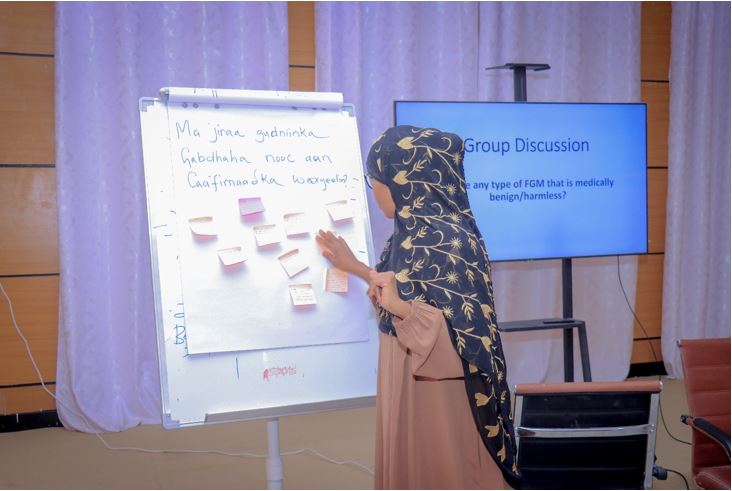
Figure: Facilitator capturing participants’ opinions on the existence of medically benign or beneficial FGM.
4.5 Crafting Framework for Community Action Plans (CAPs
The training culminated in a dynamic group task where participants, working in pairs, translated their newfound knowledge into actionable strategy. The energy in the room was focused and determined as they brainstormed the framework for their Community Action Plans. The following pillars, illustrated with the participants’ own words, demonstrate a deeply contextual and community-owned approach.
Pillar 1: Survivor Support – A Holistic Vision for Healing
The activists outlined compassionate and comprehensive support, encompassing medical, psychological, and social needs
Integrated Healthcare: Emphasis was placed on accessible medical treatment for bleeding, infection, and childbirth complications
Psychosocial and Empowerment Support: Plans highlighted mental well-being, counseling, and encouraging education and community participation.
FGM Prevention
Pillar 2: Prevention & Protection – Building a Multi-Layered Defenseistic Vision for Healing
Strategies targeted all community levels with education, empowerment, and enforcement.
Awareness and Education: A general call for continuous, targeted awareness campaigns for parents, practitioners, and the community (Figure 5).
Empowering Girls and Countering Misinformation: Key strategies included teaching girls about bodily rights and correcting religious falsehoods directed at parents. (Figure 8).
Legal Enforcement and Collaboration: Participants stressed the need to strengthen laws against perpetrators and collaborate with religious leaders and parents. (Figure 6-7)..
Pillar 3: Creating a Protective City – A Unified Vision for an FGM-Free Qardho
This pillar captured the ultimate ambition: a fundamental, systemic shift.
Policy and Legal Action: The cornerstone was clear government policy and penalization of perpetrators. (Saxar la’ Group, Badbaado Group).
Community-Wide Mobilization: They envisioned a city united in its commitment to protecting girls. (Saxar la’ Group).
Qardho Chart- Pathway to End FGM
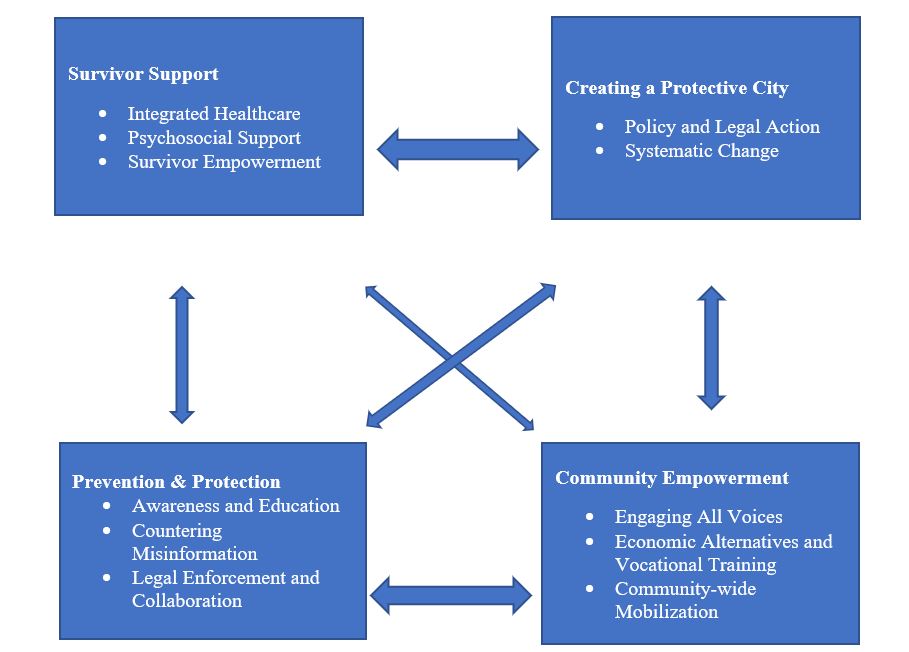
4.6 Key Learnings and Agreements.
At the conclusion of the training, participants synthesized their key takeaways, demonstrating a profound shift in understanding and commitment:
To prevent violence committed against girls.
To spread that FGM has no place in Islamic religion.
To completely eradicate FGM.
To raise awareness about FGM among all sectors of the community.
To serve the community in the sincerest way to stop the cutting of girls, and to inform them that FGM is not recommended in our religion and there is no clear evidence for it.
What do we agree each other/ learned from the session?

Conclusion of CAP Development:
The ideas generated were not ideal abstracts, but a practical, urgent, and community-owned blueprint for change. The participants successfully demonstrated that they are not just beneficiaries of a training but are now strategic leaders, ready to champion the movement to end FGM in Qardho. Their plans are a testament to their commitment and a clear signal that the future of this fight is in passionate, local hands.

5.0 Key Results and Outcomes
A core team composing of 10 university student activists was established, and equipped with advanced and evidence-based knowledge.
Activists were empowered to effectively counter the deepest-rooted justifications for FGM, particularly the conflation of the “Sunna” type with Islamic doctrine and the misconception of its medical acceptability.
Preliminary framework for Community Action Plans was crafted laying groundwork for community-owned roadmap to end FGM.
6.0 Challenges and Lessons Learnedesults and Outcomes
Limitations of the Framework: The preliminary CAP frameworks have not yet incorporated components for Monitoring, Evaluation, and Learning (MEL). Furthermore, strategies for managing community resistance and responsive feedback mechanisms were not fully developed
Sustaining Nuanced Understanding: The deep-seated nature of the “Sunna” misconception requires continuous reinforcement. Effectively communicating this complex religious argument to a wider audience remains a challenge that necessitates ongoing practice and support.
7.0 Conclusion and Way Forward
This advanced training successfully created a vanguard of knowledgeable, skilled, and highly motivated university student activists. They are now armed not only with the “what” but, more importantly, with the “why” and the “how” to advocate for FGM abandonment in their community
Way Forward:
SAAD will support the activists in the next phase of training to incorporate MEL components into their CAPs and develop appropriate messaging techniques to reduce community resistance. SAAD extends its profound gratitude to GIZ for their unwavering support and to MOWDAFA for their invaluable technical and collaborative partnership in empowering the youth of Puntland to become the architects of a safer, FGM-free future.
Submitted by:
Ahmed Isse, Project Officer
Smart Aid and Development Organization

